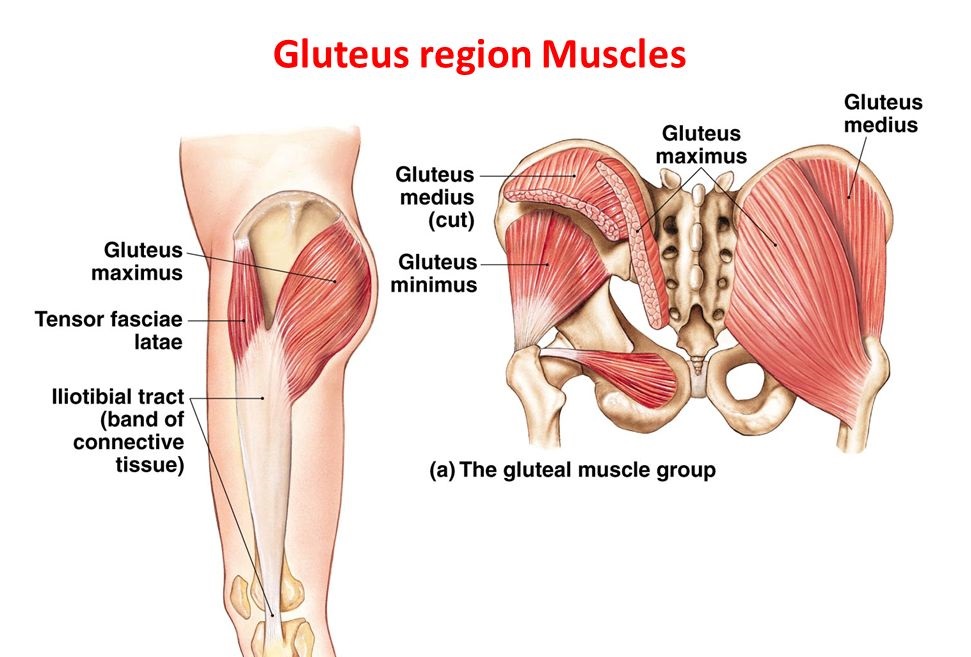What is the gluteus medius muscle?
The gluteus medius is a muscle located in the hip region and is one of the three muscles that make up the gluteal group, along with the gluteus maximus and gluteus minimus. It is responsible for stabilizing the hip joint and controlling the movement of the thigh bone (femur) during activities such as walking, running, and climbing stairs. The gluteus medius also helps to rotate the thigh bone, which allows for movements such as kicking and turning. (1)
Origin, insertion and function
Origin:
The origin of the gluteus medius muscle is the outer surface of the ilium (the upper part of the hip bone).
Insertion:
It inserts on the lateral surface of the greater trochanter of the femur (the bony prominence on the upper thigh bone).
Function:
The gluteus medius muscle plays an important role in stabilizing the hip joint, controlling the movement of the thigh bone (femur) and helps to rotate the thigh bone, which allows for movements such as kicking and turning. The muscle helps to keep the body balanced by preventing the pelvis from dropping on the side of the weight-bearing leg and also helps in maintaining correct posture. It also plays a role in hip abduction, and assisting with internal and external rotation of the hip.

Common signs of a weak gluteus medius
Signs that your gluteus medius muscle may be weak include:
- Pain or discomfort in the hip or knee
- Difficulty balancing on one foot
- An exaggerated inward tilt of the pelvis (also known as “duck butt” or “sway back”)
- An increased arch in the lower back
- Knee pain or discomfort, especially when climbing stairs or running
- Difficulty standing on one leg, such as when getting dressed
- A limp or uneven gait (walking pattern)
- A feeling of instability or “giving way” in the hip or knee
- Weakness in the hip or thigh when performing exercises such as squats or lunges.
Exercises that strengthen the gluteus medius muscle
Exercises that make your gluteus medius stronger include:
Bodyweight exercises:
Clamshells:
- Lie on your side with your legs bent at a 90-degree angle and your feet together.
- Keep your feet touching each other and your torso still as you lift your top knee as high as you can without moving your pelvis.
- Lower your knee back down and repeat the movement.
Side-lying leg raises:
- Lie on your side with your legs straight and your feet together.
- Slowly lift your top leg as high as you can without moving your pelvis.
- Lower your leg back down and repeat the movement.
Fire hydrants:
- Start on all fours with your hands directly under your shoulders and your knees under your hips.
- Keep your knee bent and lift your right knee out to the side as high as you can.
- Lower your knee back down and repeat the movement.
Resistance band exercises:
Resistance band side steps:
- Stand with your feet hip-width apart and wrap a resistance band around your legs just above your knees.
- Step out to the side with your right foot and then bring your left foot in to meet it.
- Repeat the movement, stepping out to the side with your left foot and then bringing your right foot in to meet it.
Banded hip abduction:
- Lie on your side with your legs straight and place a resistance band around your ankles.
- Keep your feet together as you lift your top leg as high as you can without moving your pelvis.
- Lower your leg back down and repeat the movement.
Banded donkey kick:
- Start on all fours with a resistance band around your ankles.
- Keep your knee bent and lift your right foot up towards the ceiling as high as you can.
- Lower your foot back down and repeat the movement.
It is also important to note that these exercises should be done under proper form and technique, and it is always recommended to seek a professional advice before starting any new exercise.
References:
- Shah A, Bordoni B. Anatomy, Bony Pelvis and Lower Limb, Gluteus Medius Muscle. [Updated 2022 Nov 28]. In: StatPearls [Internet]. Treasure Island (FL): StatPearls Publishing; 2022 Jan-. Available from: https://www.ncbi.nlm.nih.gov/books/NBK557509/
